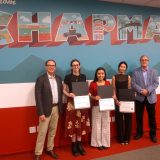
Celebrities of the Digital Commons: Dr. Pamela Ezell
July 15, 2020
A few months have passed since the Chapman University Digital Commons met the exciting milestone of one million downloads, but we’re celebrating it all summer long here at the Leatherby Libraries! So far, we’ve spoken to Chapman professors whose work has exciting distinctions: Dr. Jared Rubin, whose article has the most downloads in the Commons, and Dr. Laura Tsu, whose article was the one millionth download. Today, we’re talking with someone whose dissertation in the Digital Commons makes her a very special Chapman University star: she’s a triple alumna, the parent of two Chapman students, and the Assistant Vice President of Communications! Dr. Pamela Ezell spoke with us about her dissertation, “Counter-stories of First-Generation Latinx Alumnae: A Critical Race Theory Analysis.”
The abstract for Dr. Ezell’s dissertation reads as follows: “This study includes the experiences of six first-generation Latinx alumnae who attended three private, predominantly-White universities in Southern California. It applied a critical race theory (CRT) framework and an anti-deficit ideology to their experiences. Importantly, because the participants and the researcher are of different identities, the study employed principles of culturally responsive methodologies (CRM). Most quantitative research and existent theory concerning first-generation Latinx collegiate women excludes the voices of first-generation Latinx alumnae, so this study included the telling of their counter-stories concerning their undergraduate experiences. These experiences included identity-threat, microaggressions, and the enactment of White privilege. Additionally, their counter-stories contradict majoritarian stories concerning first-generation students and their families, as well as institutional values of fairness, meritocracy, colorblindness, and diversity. The methodology of the study was CRT counter-storytelling. Concepts of narrative inquiry informed the research design. Counter-stories of the participants were shared during conversations and interviews, then interpreted using the framework of CRT and a method of thematic analysis. All members of the study have graduated with a bachelor’s degree, and their experiences provide direction for additional research concerning first-generation theory as it applies to Latinx collegiate women, as well as implications for policy and praxis regarding the future experiences of Latinx students on U.S. higher education campuses.”
Dr. Ezell shared the following about her experience using the libraries and the Digital Commons at Chapman University:
“I am a Chapman library wonk. As a “three-peat” Chapman alumna and two-time Chapman parent, I have had the distinct pleasure of visiting two iconic Chapman libraries: the Thurmond Clarke Memorial Library, a building that looked a lot like a bank’s corporate headquarters, and the grand on the outside, comfortable on the inside Leatherby Libraries. However, it was not until I embarked on the four-year journey of earning my Ph.D. at Chapman, in 2014, that I learned to really use the many resources provided at no cost by the library. The Leatherby Libraries was my silent partner throughout my doctoral studies in education. I borrowed numerous texts, procured dozens of articles via Interlibrary Loan, conducted confidential qualitative research in meeting rooms, chatted with the Reference Desk on multiple Sunday afternoons, and searched the subscription databases countless times.
It was during one of those database searches, while perusing dissertation titles and approaches on the topic of “first-generation students,” (my dissertation topic), that I stumbled across a familiar name: “Arredondo, Marisol.” I know her, I thought. Chapman’s Director of Institutional Research and Decision Support, Marisol Arredondo Samson, had written her dissertation at UCLA on the topic of first-generation students 18 years earlier. Today, first-generation students are of great interest to institutions of higher learning. At the time of her research, in the 1990s, Dr. Arredondo Samson’s work addressed a gap in researchers’ understanding of the first-generation experience. The following week, I sent her an email, asked her if she would serve on my dissertation committee and she said yes. Her support of me and her work on my behalf was invaluable. I can’t think how else I might have learned of our common research interest without the library’s open access to the ProQuest database where her dissertation is housed.
As a library wonk, I also learned about and accessed work within Chapman’s Digital Commons. There’s no shame in admitting it if you don’t know what a digital commons is. It’s a library database with dissertations, scholarly papers, conference presentations and more that Chapman houses and makes available to the world for free. When it came time for me to finish my dissertation and submit it for degree consideration, again, Leatherby Libraries was an invaluable resource. Coordinator of Scholarly Communications Kristin Laughtin-Dunker not only explained the process to me and answered all my technical questions, but if not for her help, I might still be ABD – “all but dissertation.”
Since I know that financial resources can be scarce for students and scholars, I wanted my dissertation to be part of the “free” library, and it is.
As the mom of an MBA student and a Film and Television Production major, I’ve seen both of my kids use the “on-ground” and the “digital” library services. They’ve been going there since they were kids and, as “digital natives,” they have mad research skills. I believe the key to being a success in life now and in the future is knowing how to access research and add new findings to what is known in the world. Chapman’s Leatherby Libraries makes it possible for all of us to be lifelong learners.
Now that our campus operations are largely remote, I do miss visiting the library. When you can’t find a movie on Netflix or Amazon Prime, chances are, the Leatherby Libraries might have a copy of the DVD. (If you no longer have access to a DVD player, you can watch it in their media room.) I like browsing the stacks and finding a book stamped “Chapman College.” I feel a part of our shared history when I’m in the library.
My advice to everyone at Chapman: if you’re not using the Leatherby Libraries, start. These and a multitude of other benefits are available to you as a privilege of being a Chapman student, faculty or staff member. Happy researching!”

